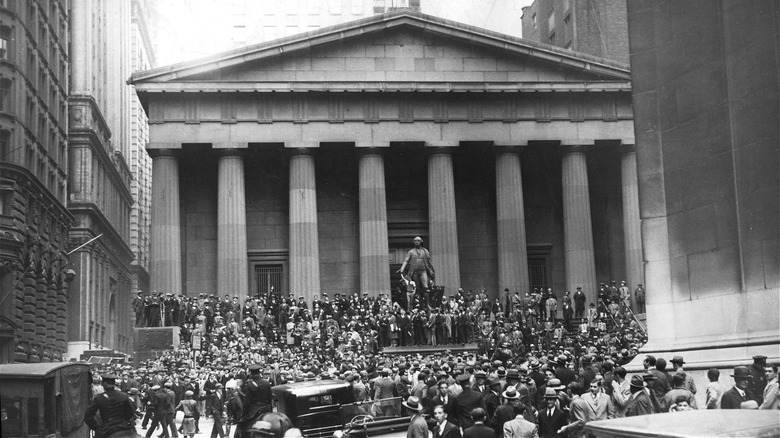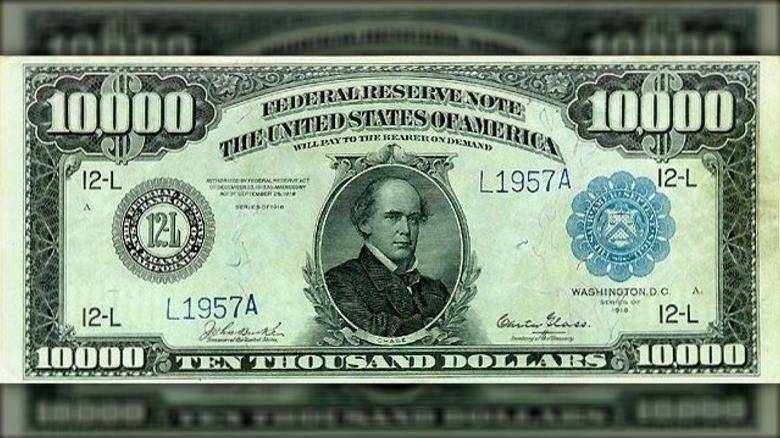The Unexpected Value Of A Rare Great Depression-Era $10,000 Bill
A while back, Money Digest outlined the history and the potential value of the rare $100,000 bill. Somewhat disappointingly, the $100,000 bill was never intended for public circulation and in fact, it's downright illegal for a private citizen to own one. As a consolation, you'll have to settle for the next highest denomination: the $10,000 bill.
Nowadays, the most impressive note cranked out by the Bureau of Engraving and Printing is the $100 bill, but in the past, it printed $500, $1,000, $5,000, and yes, $10,000 bills. What's particularly interesting is that these larger bills were officially discontinued from distribution in 1969, but none had actually been printed since 1945. Presumably, the bills that were supplied between 1945 and 1969 were "new old stock," as they say in certain industries.
Besides the fact that such large denominations were impractical for typical transactions, such as paying for drinks or a meal, they also drew attention as a holy grail for counterfeiters. Nowadays, these big bills are highly coveted by collectors. In fact, some examples are worth more than the average price of a house.
It took many Americans years to earn $10,000
The $10,000 bill we're discussing was produced in 1934, putting it smack dab in the midst of the Great Depression, a severe economic downturn following the 1929 stock market crash that affected both the United States and the world. Without a doubt, there's a certain irony in the production of such a large denomination bill at a time when so many Americans were struggling financially. With an unemployment rate that eventually crested 20%, many folks were lucky to have jobs at all and $10,000 represented several years or more worth of salary for many.
Like previous $10,000 notes that were printed in 1918 and 1928, the 1934 versions also featured a portrait of Salmon P. Chase on the front (who decides what face is on bills, anyway?). In case your history classes missed discussing Chase, he was secretary of the treasury under President Abraham Lincoln. The back of the earliest $10,000 bills depicted Pilgrims on board a ship heading for North America, but later examples just read "The United States of America — Ten Thousand Dollars" on the back.
Condition is everything for currency collectors
In spite of its more simplistic design, one particular $10,000 bill from 1934 recently sold for a bundle. How much? Try almost 50 times its considerable face value. That's right, at a September 2023 auction of coins and currency held in Dallas, Texas, our subject bill fetched a whopping $480,000. Though rarity certainly had a role in the high valuation, it was really the remarkable condition that attracted serious collectors.
According to a grading organization called Paper Money Guaranty, the auctioned bill was rated as being in virtually the best condition possible. In a press release, Dustin Johnston, vice president of currency at Heritage Auctions, which sold the 1934 $10,000 bill, said, "Large-denomination notes always have drawn the interest of collectors of all levels. The $10,000 trails only the $100,000 gold certificate issued in 1934, and of the 18 examples graded by PMG, this example is tied for the highest-graded."
That excellent condition only stands to reason since the auctioned bill was socked away since new instead of being put into circulation for its intended purpose. If you're curious, the total value of items sold at Heritage's auction exceeded $15 million, including a $20 coin from 1899 that fetched $468,000.

